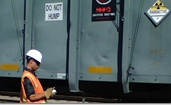
Four Public Meetings Set on Hazmat Railcar Changes
The Pipeline and Hazardous Materials Safety Administration and the Federal Railroad Administration published a proposed rule April 1 that will require stronger railroad tank cars for transporting poison inhalation hazard materials. The agencies on Monday announced four public meetings in May to receive comments on the rule, with the first meeting (May 14) limited to transportation of chlorine and the second (May 15) to transportation of anhydrous ammonia. Together, those two chemicals account for almost 80 percent of all PIH rail tank car shipments annually.
The other meetings will take place May 28 and May 29. All four will begin at 9 a.m. at the Washington Plaza Hotel, 10 Thomas Circle NW in Washington, D.C. Anyone wanting to present an oral statement at any of the meetings should notify Lucinda Henriksen in FRA's Office of Chief Counsel at [email protected] or 202-493-1345 at least four business days before the date of the meeting in question.
The proposed rule would set a maximum speed limit of 50 mph for all rail tank cars that transport PIH materials and a maximum speed limit of 30 mph in non-signaled territory, unless the tank car meets the enhanced tank-head and shell puncture-resistance systems performance standards proposed in the rule, which are a shell puncture-resistance system capable of withstanding impact at 25 mph and a tank-head puncture-resistance system capable of withstanding impact at 30 mph.
The May 28 meeting will focus on transport of PIH materials other than chlorine and anhydrous ammonia (such as ethylene oxide, anhydrous hydrogen fluoride, sulfur dioxide, an hydrogen chloride) and on the operational restrictions proposed, the impact of heavier tank cars on railroad infrastructure, and other issues. The May 29 meeting will be an opportunity for interested parties to present general comments related to the proposal and/or concluding remarks.